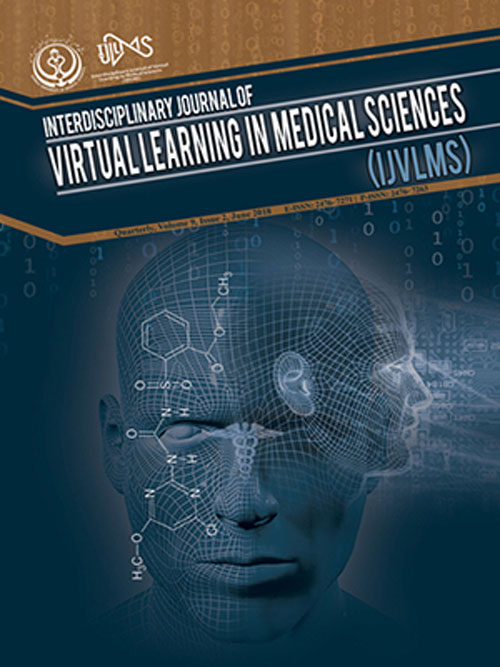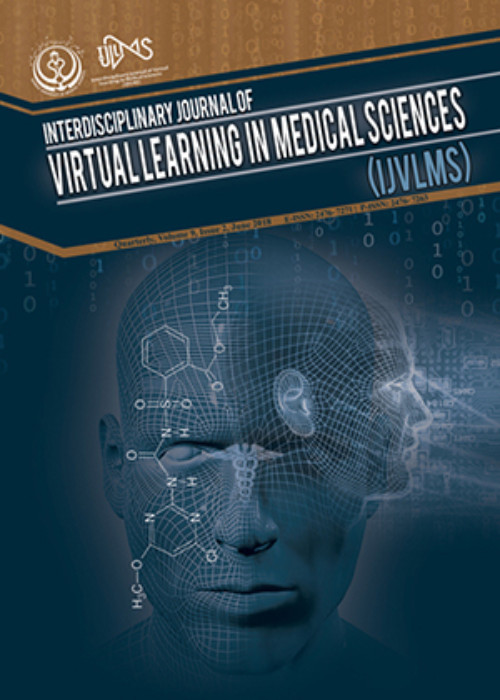فهرست مطالب

Interdisciplinary Journal of Virtual Learning in Medical Sciences
Volume:11 Issue: 3, Sep 2020
- تاریخ انتشار: 1399/06/17
- تعداد عناوین: 8
-
-
Pages 139-152Background
Game-based instruction is one of the methods that encourage exploration among learners. Identifying and incorporating exploratory components should be considered as a principal goal in designing a game that provides exploratory instruction. The present study aims to investigate the exploratory components of an educational game.
MethodsA systematic review of the literature was performed in accordance with PRISMA guidelines. Based on the inclusion criteria, a comprehensive search was conducted in Google Scholar, ProQuest, ScienceDirect and Scopus for articles published between 1995-2019. A combination of keywords were used in the search, including ("educational game" OR "serious game" OR "adaptive game") AND ("player type" OR "player style" OR "player modeling" OR "Bartle player style" OR "explorer player"). A manual search was also conducted in Google to identify more literature. Furthermore, out of 1034 articles, 39 were studied in depth.
ResultsThe obtained components were categorized in six sections, including: educational elements (research, serious game, projectbased activities, test hypotheses, question and answer, role play, simulation), exploratory dynamics (exploration, solving, collecting, and build), mechanics (chance, conflict or challenge, collaboration [negative relationship], prizes upon completion, non-linear space, existence of creative tools, existence of ancillary equipment, guidance, open content, customizability, access to all facilities, different ways to study elements and environment, and puzzle), aesthetics, branch stories and proportionality, exploration-based games (emphasis on the pivotal challenge to success, emphasis on meaningful choices, emphasis on thinking versus physical work, emphasis on longer game sessions, no punishment, emphasis on freedom versus control, emphasis on details versus imagination).
ConclusionDesigners can draw on these components when developing a game that suits the learners’ styles. Analysis of the studies showed that the obtained components could be used in educational game design, and the obtained framework is a useful guide for game designers.
Keywords: Educational Game Design, Explorer Player Style, Bartle Player Styles, Discovery Game -
Pages 153-161BackgroundEducation, labor market, and social behaviors of young people are among the key factors in a country's scientific and administrative policy making. The level of public knowledge and the skills of specialists in all sectors of a national economy are the determinants of successful development. This study aims to identify the most crucial labor market conditions affecting students’ enrollment at Payame Noor University (PNU) in Iran.MethodsTo fulfil the research objectives, the data were analyzed using a qualitative method (content analysis). At first, the indicators and variables were extracted using Delphi method and document examination, and then these indicators were distributed among 15 professors of higher education, economics, and social sciences to be reviewed and corrected. The required data were collected from the Statistical Center of Iran, Ministry of ‘Cooperatives, Labor and Social Welfare’ and the Center for Statistics at PNU. The Ordinary Least Square regression model (OLS) was used to analyze the data collected from undergraduate students attending the PNU courses between 2001-2014.ResultsThe OLS results showed that the total labor force (Beta=2.824, P=0.017) and high school workforce population (Beta=0.399, P=0.007) had a positive and significant effect on student enrollment at PNU. The number of industrial workshops (Beta=-0.078, P=0.649) had a negative impact on student enrollment at PNU.ConclusionsThe total labor force and high school workforce population had a significant impact on student enrollment at PNU. Therefore, strategic planners in open and distance universities should consider the market conditions in their academic strategies. The policy makers at Payame Noor University should focus their plans on the areas that appeal to all high school graduates. Also, they need to provide training opportunities for the people already working in the industrial sector.Keywords: Labor Market Conditions, Payame Noor University, Distance University
-
Pages 162-169BackgroundThe rapid growth of information and communication technology has brought about substantial changes in educational practices and approaches. Education and training have received more attention in view of technological developments and emerging requirements. The aim of this study was to investigate school principals’ application of Technology Acceptance Model (TAM) in smart schools of Qom, Iran.MethodsThis was a descriptive-correlational study. The study population included all smart school principals in Qom in 2018. Purposeful sampling was applied to identify and select 70 principals as the participants of the study. Davis’ TAM questionnaire with a reliability coefficient of 0.78 was used for data collection. Descriptive statistics, including mean and standard deviation, were calculated for data analysis, and Pearson correlation coefficient was used in the inferential analysis.ResultsSignificant positive relationships were observed between perceived usefulness and attitude towards the use of technology (r=73, P<0.01), perceived usefulness and willingness to use technology (r=64, P<0.01), perceived ease of use and attitudes towards the use of technology (r=39, P<0.01), perceived ease of use and perceived usefulness of technology (r=43, P<0.01), and finally the tendency to use and actual use of technology (r=63, P<0.01).ConclusionIn order to improve the performance of smart schools, it is recommended to cultivate a positive and constructive attitude towards technology among principals and teachers in a dynamic way.Keywords: Technology Acceptance, TAM model, Smart Schools
-
Pages 170-179Background
Today, e-learning has become an integral part of educational practice around the world and plays a relatively significant role in student learning. E-learning is an educational approach in which educators and learners make use of electronic tools and technologies to communicate with each other in spite of distance and lack of close communication. The purpose of this study was to compare the effects of e-learning and conventional methods on the academic motivation and performance of fifthgrade elementary school students in Shiraz, Iran.
MethodsA descriptive study was conducted in 2019-2020 academic year. A convenience sampling method was applied and the research sample consisted of 268 students (134 in e-learning group; 134 in conventional education group). Data collection tools included the EPT questionnaire (Based on Pham and Taylor) and the academic motivation questionnaire (Vallerand et al.). Independent t-test was used for data analysis.
Resultsthe results showed that the mean of the academic motivation among the e-learning students is higher than the conventional learning students (P<0.001). Furthermore, in terms of academic performance, the mean score of the motivation component in the e-learning group was higher than the conventional education group (P=0.03). There was no significant difference between the two groups in other components of the academic performance.
ConclusionThe results showed that e-learning had a greater impact on student motivation. More research with larger samples is required to better understand the possible advantages of this method.
Keywords: E-Learning, Conventional education, Academic Motivation, Academic Performance -
Pages 180-190BackgroundPermanent access to virtual social networks enables individuals to use them as a platform for continuous learning. This study aimed to identify and analyze the factors affecting the use of social networks for virtual learning purposes.MethodsThis was an applied research using descriptive-analytic design and partial least squares structural equation modeling (PLSSEM) for data analysis. The statistical population consisted of 110 students (including 98 freshmen) studying sociology at Payam Noor University, Tehran Center, Iran. The participants were active users of at least one of the social networks under study. A researcher-made questionnaire was developed using elements from similar research tools such as Mnkandla and Minnaar (2017). To analyze the content validity of the questionnaire, the research variables were reviewed and modified based on existing standard scales and consensus opinions of 5 academic experts (using Delphi technique). Stratified sampling was applied, and the questionnaires were administered to a sample of 90 students. Finally, 72 questionnaires were completed by the participants, and statistical analysis was conducted using Smart PLS software. The reliability of the instrument, as measured by Cronbach’s alpha, was above 0.7 for all variables.ResultsThe findings showed that perceived complementary features and perceived ease of use indirectly influence students’ intention to use virtual social networks. Also, perceived usefulness (t=1.02, P>0.05) and attitude toward use (t=1.93, P>0.05) have no effect on their intention to use and ‘trustworthiness’ (t=4.13, P<0.01), and ‘flow’ has a direct effect on the intention to use the networks (t=2.05, P<0.05).ConclusionThe results of this research would further support the academics’ push for the use of social networks as a platform for virtual instruction and innovation in teaching-learning process.Keywords: Social networking, Virtual Education, Technology Acceptance Model, Higher Education
-
Pages 191-199Background
Hospitalization of elementary students with chronic illnesses could limit their engagement in school activities and result in academic failure. The purpose of the present study was to determine the effectiveness of e-learning on these students’ academic performance in mathematics.
MethodsThis was a pretest-posttest semi-experimental study with control group. The population included all the fifth or sixth-grade elementary school students hospitalized at least once in the school year 2019-2020 in Imam Hussain Pediatric Hospital of Isfahan, Iran. The sample size consisted of 60 students (26 in 5th grade and 34 in 6th grade) who were selected by convenience sampling and divided equally into experimental and control groups. Data gathering tools included two researcher-made mathematical quizzes designed to assess the students’ academic achievement in mathematics. Each quiz was about Decimal Numbers as covered in the corresponding grade level. Data were analyzed through an analysis of covariance using SPSS 21 software.
ResultsIn terms of academic achievement, the mean and standard deviation of post-test scores in the experimental groups (8.26±1.22) were higher than in the control group (6.60±1.47). In addition, ANCOVA test results revealed that after the elimination of the pretest effect, the F of the independent variable (59.461) was significant at the confidence level of 99% (P<0.001). Thus, posttest scores of experimental and control groups were significantly different.
ConclusionGiven the significant impact of e-learning on the mathematical performance of hospitalized elementary school students, it is recommended to use this approach for hospitalized learners.
Keywords: E-Learning, Chronic diseases, Hospitalization, Academics achievement -
Webinar Technology: Developing Teacher Training Programs for Emergency Remote Teaching amid COVID-19Pages 200-203
In the light of the COVID-19 pandemic, schools worldwide are compelled to find new ways of providing education to their students. Educational institutions are shifting to emergency E-learning, while their underprepared teachers find themselves confronted with numerous unexpected challenges of emergency remote teaching (ERT). Teachers are not fully prepared and professionally trained to teach through ERT, while they also struggle with the challenges that arise from the lack of readiness for an abrupt transition from conventional curriculum to online-based curriculum. To mitigate the dilemma that the teachers experience in delivering instruction amid COVID-19, educational institutions switched to digital technologies to empower the teachers as frontline workers during the pandemic. As a result, the teachers in most countries throughout the world are undergoing training through webinar technology. Holding webinars to train the teachers can pave the way to address the challenges in remote teaching while simultaneously preventing the spread of the novel coronavirus.
Keywords: COVID-19, Emergency Remote Teaching, ERT, Webinars, Webinar-Based Training, Professional Development, Online Training, Virtual Learning, Emergency E-learning, Webinar Technology -
Pages 204-205
Today, with the advent of computers, smartphones and communication networks, telecommunications have become more widespread than ever, meaning that computermediated communication (CMC) has now been formed (1), and it is largely text-based (2). In this type of communication, it is not always possible for people to fully express themselves, or there might be ambiguities in the messages that they receive. In other words, a receiver’s interpretation of a text might be semantically different from what the sender intends, and there is no semantic affinity. The most important factor could be the lack of non-verbal cues which can affect the transmission of information (3). Therefore, more time and further messaging are required to communicate the intended meaning (1, 4). Distance education is no exception to this rule and could even be much more challenging than regular distance communication.
Keywords: Emojis, Distance Learning, Social Networks, Non-verbal cues


